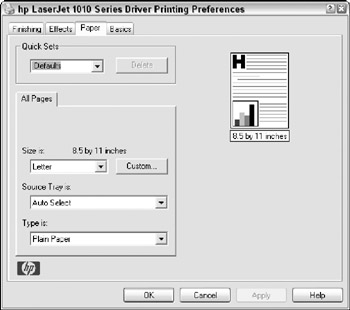Choosing and Handling Paper
One aspect that determines the size and cost of a printer is how it handles paper. All printers hold a set amount of paper, but larger printers handle great volumes of paper without requiring reloading.
| Note | Most inexpensive inkjet printers don't have a paper tray, but simply load pages from a slot in the back of the printer. |
You can specify how the printer handles the loaded paper using the Paper tab of the Printing Preferences dialog box, as shown in Figure 35.13. The options in this dialog box differ for each printer, but this tab gives you options for selecting the Source Tray.

Figure 35.13: The Paper tab of the Printing Preferences dialog box lets you select which tray of paper to use.
Some printers have multiple trays of paper. For example, an office printer may have one tray loaded with plain white paper and another tray loaded with letterhead paper, or glossy paper for printing photos. Using the Paper Type field you can identify which type of paper is loaded into each tray. You can also select the size of the paper for each tray.
Duplexing is a feature that enables a printer to print on both sides of a page without manual intervention. This can help reduce the amount of paper used, but requires specialized hardware to flip the page.
Another common setting found in the Printing Preferences dialog box is the paper orientation. If the printed page is taller than it is wide, the paper is using Portrait orientation; this is the default setting. You can change the orientation to be wider than it is tall; this orientation is called Landscape, as shown in the Basics tab of the Printing Preferences dialog box, shown in Figure 35.14.

Figure 35.14: The Basics tab of the Printing Preferences dialog box lets you change the paper's orientation.
EAN: 2147483647
Pages: 372